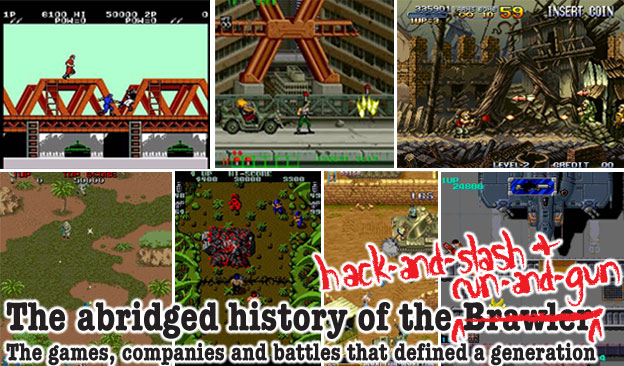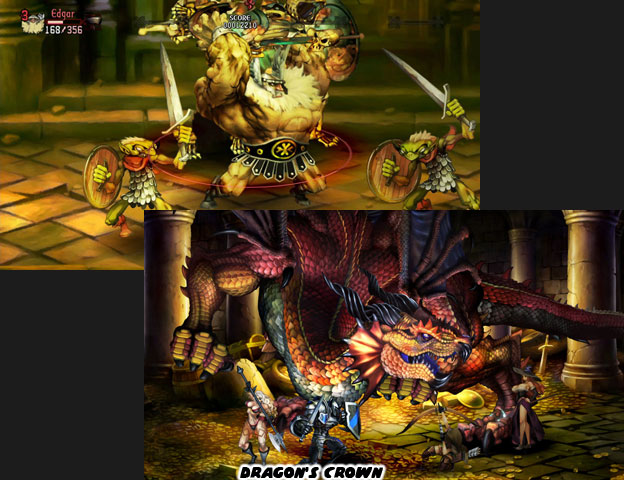
During the mid '90s all Konami and Capcom seemed capable of doing was slapping a new coat of paint on the tired mechanic in arcades. There was little separating Alien vs Predator from Warriors of Fate from Cadillacs and Dinosaurs, aside from different sprites of course. The gameplay remained the same. Players pressed the attack buttons quickly and survived the onslaught, there was not much gameplay in that. Within a decade the experiences from DMC, Gungrave, P.N. 03 and Bayonetta were also becoming redundant. I had stated this earlier in the series: "The advent of 3D technology gave players a new level of immersion and visual flare but these early 3D titles often lacked the elements that made previous 2D games memorable. Moving to 3D meant that the industry would have to start all over again and figure out how to make a good brawling experience. The studios would have to invent something that took advantage of the next generation of graphics and create the next generation of gameplay to go along with it." Japanese designers as a whole were guilty of relying heavily on visual style and forgetting the importance of substance.
The sandbox game had gained popularity past the millennium. It was successful in the west because developers had figured out how gameplay could be derived from engines which were essentially tech demos. The sandbox environment became one of the ways in which the brawler was able to survive outside of the arcade. More important it allowed the brawler to flourish in 3D and made the gameplay unique. SpikeOut and Final Fight: Streetwise borrowed dated elements, like a countdown clock, and forced players to fight wave after wave of opponents using underpowered characters, making the experience feel slow and terribly redundant. The new crop of western-developed brawlers seemed fresh and exciting by comparison.
London based Rocksteady Studios followed the classic Hokuto No Ken template and then wrapped it in a more open world. The main character would be a master of the fighting arts, far more experienced than anyone that crossed his path, capable of surviving even in mob situations but not as grossly exaggerated or overpowered as Ken. By using Batman from the comic books as the main character players could have an adventure title that was part stealth and part brawling. The 2009 release was one of the best comic-character to game adaptations ever. Rocksteady made a title that took advantage of the character and his universe. This new hero would be an acrobat, escape artist and detective and allow players to take full advantage of the 3D environments.

Those at Rocksteady did not look back at the history of the franchise to see what other Batman titles worked well or tried to repeat the 2D lessons on new consoles. Instead they had the insight and confidence that the best Batman experience would reflect the new generation of gameplay. Both Arkham Asylum and the latter Arkham City were independent from the films and comics. Warner Bros. Interactive Entertainment allowed the designers to evolve Batman into a gaming archetype especially after the movie-based titles failed to win over players. Both Arkham games had become critically acclaimed and commercially successful titles. The core of both games was the new brawling experience. Rocksteady had coined their intuitive fighting mechanic "Freeflow Combat." A few button presses allowed players to easily take down waves of opponents. It was something never before possible in a fighting game. To be fair though Capcom, Spike and Sammy had made variations of the game mechanic many years earlier.
Another western studio would become even more popular by following the lessons taught by the brawler. The team at Naughty Dog started out creating great mascot titles like Crash Bandicoot, as well as Jax and Daxter. Yet like Star Team did when they left Konami and created Guardian Heroes, there was much more potential in a new character and game idea. When the studio pursued a new type of experience free from license and conventions they forever changed the industry. Uncharted: Drake's Fortune was a 2007 sleeper-hit It seemed to come out of nowhere and redefine the adventure title as Tomb Raider had done so a decade earlier. Naughty Dog had taken the lessons from the run-and-gun and incorporated them into a sandbox environment. The main character, Nathan Drake, was not the unstoppable fighter that Batman was, he was however more than average at brawling. He was certainly above average as a marksman and as an athlete as well but not as over-the-top as Laura Croft or Rubi Malone. These things made the character and his adventures believable while not leaving him so weak as to make the gameplay dull.

The follow up titles Uncharted 2: Among Thieves from 2009, Uncharted 3: Drake’s Deception from 2011 and Uncharted 4: A Thief's End from 2016 incorporated many of the great moments from gaming and cinema into an interactive experience. There were huge set pieces and big stunts every bit as spectacular as a multi-million dollar blockbuster. Were the fights in exotic locations or shootouts on moving trains inspired by adventure films or classic brawlers? Could the developers have been allowing both influences to shine through as a collective experience? Quite possibly yes. In a Rolling Stone interview Neil Druckmann the Director of Uncharted 4 mentioned that the original version of the game, as in the first Uncharted was much more brawling oriented. It's great that they changed the game play to incorporate all of the new things that these heroes could do, including driving vehicles, and running along rooftops.
The brawler did not die and never would. The US, UK and Europe were now capable of developing memorable titles based on the legacy built by Japan. God of War, Arkham City and Uncharted were the new respective hack-and-slash, beat-em-up and run-and-gun for the next generation. The genre had matured and developed into amazing 3D experiences because the people that developed them had grown up on 25+ years of fantastic designs, graphics and gameplay. Sure there was still life left in the traditional brawler, Castle Crashers and a score of arcade gems finding their way onto XBL and PSN were proof of that. Vanillaware, the studio that released the visually arresting games Muramasa the Demon Blade and Odin Sphere blew the doors off the hack-and-slash with Dragon’s Crown in 2013.
Vanillaware had studied the genre very carefully and created a game that had brawler, RPG and hack-and-slash elements. It took pieces from more than 20 years worth of brawlers, locations, characters and stories reminiscent of Magic Sword, Arabian Magic, Dungeons and Dragons: Shadow Over Mystaria and Tower of Doom, Golden Axe and many more timeless arcade games. It created something never quite seen before with graphics that were unparalleled. Best of all, like the classic brawlers this was a game that could be enjoyed with a group of friends. Never satisfied, the Japanese would continue to try to make even bigger spectacles and over-the-top moments with the genre, insuring that their contribution would live on.

The brawler now represented something not as obvious as a sports game, combat game, racing game or puzzle game. It had become the heart of the best and most memorable moments in gaming. In 15 or 20 years the next generation of designers would be inspired by these experiences They would continue building on the legacy and show the entire industry that in the end the brawler won the fight.
I hope that you have enjoyed my 30-part series on the brawler. I am constantly researching and preparing new blogs for my readers. Sometimes they are ready right away and sometimes they can take months to come together. If you would like to sponsor me please visit my Patreon page and consider donating each month, even as little as $1 would help. I plan on creating more podcasts and videos and could always use a little help buying some better equipment. Thank you for visiting!

No comments:
Post a Comment